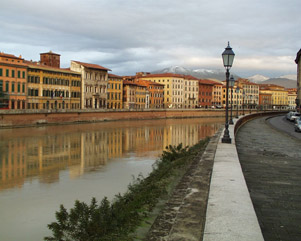A town both big and small
 Pisa has often been described as a radiant city, a serene and horizontal town without any of those sharp contrasts which characterize many medieval Tuscan and Italian towns. What strikes you most in Pisa are the wide spaces , the brightness of the sun in summer, the placid flow of the river Arno under the bridges, the salty smell of the breeze coming from the sea. Pisa has a mild and relaxing climate as so many visitors - Byron, Shelley, Leopardi to name only a few - have remarked. Surrounded by its mountains, yet close to the sea, Pisa will engulf you in its special atmosphere and will make you dream of its old cosmopolitan life open to all influences coming from North and South, from East and West.
Pisa has often been described as a radiant city, a serene and horizontal town without any of those sharp contrasts which characterize many medieval Tuscan and Italian towns. What strikes you most in Pisa are the wide spaces , the brightness of the sun in summer, the placid flow of the river Arno under the bridges, the salty smell of the breeze coming from the sea. Pisa has a mild and relaxing climate as so many visitors - Byron, Shelley, Leopardi to name only a few - have remarked. Surrounded by its mountains, yet close to the sea, Pisa will engulf you in its special atmosphere and will make you dream of its old cosmopolitan life open to all influences coming from North and South, from East and West.
Pisa is situated at the centre of the "Piana di Pisa", the largest plain in all Tuscany , a wide and fertile alluvional territory limited by the two main rivers of the region, the Arno and the Serchio, where they are approaching the sea. Pisa has benefitted since immemorial time from a priviledged geographical position which has favoured trading with distant places and with the whole of Tuscany.
A melting pot for different people, different cultures and traditions, the town has preserved trough its long history its open and cosmopolitan spirit. Inside the comparetively small inner medieval centre, alongside the extraordinary buildings of the Republic of Pisa, one can still see traces of the Etruscan and Roman past , but also the wide squares, the renaissance and baroque churches and palaces built by the Florentine during the XVIth and XVIIth century. Outside the old city walls, residential areas, research institutions and industrial buildings were developped at the end of the XIXth and expecially the XXth centuries. So in Pisa you can find almost anything; the narrow and dark medieval streets in the historical centre, the hidden but elegant baroque churches, the magnificent architectures of the Pisan-Romanesque period , the modern structures of today's Pisa.
Today the economical and social character of Pisa reflects the spirit of a town which is receptive to all new stimuli. Pisa numbers about 92.000 inhabitants many of whom are students coming from other regions to study at its famous university. The economy is mostly service-oriented: besides the university and the hospital - both of very high scientific level - you can find elegant shops, commercial centres and small industries. The international Galileo Galilei airport is the most active in Tuscany and one of the most important and safe in Italy.
Pisa is in sense an anomalous city: a provincial town with a cosmopolitan vocation, whose influence extends to the coastal part of Tuscany which looks to Pisa for its technical and specialistic needs.
It is a crowded town too, full of students, tourists, shops and offices. Of course there are problems too: the traffic is heavy, the cost of real estate is high, but these problems are in a sense the legacy of an old past and the town of the new millennium is perhaps not too dissimilar from the Pisa of its golden time crowded with merchants and sailors of every language and religion, coming to Pisa from every country
